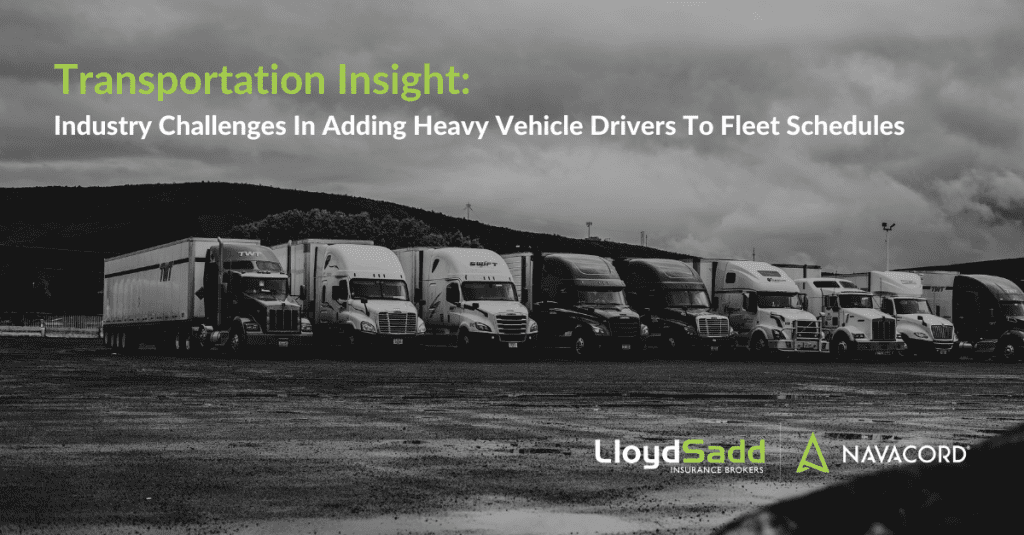Industry Challenges In Adding Heavy Vehicle Drivers To Fleet Schedules

With 20,0000 truck driver positions currently unfilled in Canada, businesses that operate commercial vehicles have experienced difficulties finding, and hiring qualified and experienced drivers. 61% of companies looking to hire commercial vehicle operators report they cannot find them.
Further compounding this issue is the insurance market’s hesitance in insuring commercial drivers with less than 3 years of experience with heavy vehicles (gross vehicle weight over 4,500 Kgs.). The lack of insurance options for these newer drivers has become a hot topic over the last year, and this article addresses that issue.
THE NEW NORM
Under a blanket commercial automobile fleet policy, vehicles and drivers can be added to the policy throughout the course of the policy term. The traditional way of adding new drivers would be to notify your broker when a driver has been hired, and they would, in turn, notify the Insurer.
However, with the insurance industry facing poor and deteriorating loss experience in the trucking sector (including contractors with heavy fleets), the Insurers’ deep dive into their claims revealed that inexperienced drivers accounted for a disproportionate share of their claims (case in point, the catastrophic Humboldt accident
– which claimed 16 young hockey players lives and is in the courts for multiple $10Million+ civil action – was a result of negligence of a driver with under 2 years experience).
As a result, before endorsing a new driver, Insurers now request evidence of at least 3 years continuous experience with heavy vehicles.
TO REPORT OR NOT REPORT?
Despite a minimum of 3 years experience becoming the standard requirement by Insurers, some businesses (and some insurance brokers) choose to take a “head in the sand” approach, by omitting to inform the Insurer of newly added drivers until the annual filing of their driver’s list, leaving it to the insurer to discover the additional driver(s) on their own accord, and in due course around renewal time.
The problem with this approach is that when the policy comes up for renewal, the insurer will review the updated drivers list, and may refuse coverage to the inexperienced operators.
What is a business owner to do with those drivers then, given that they were hired some time ago for the purpose of driving heavy vehicles?
OTHER RISKS WITH THE “HEAD IN THE SAND” APPROACH
Most Insurance company policy wordings do not specifically exclude drivers who have not been scheduled on a submitted driver’s list. That said, the government mandated auto policy wording states:
“You must promptly tell us of any change in information supplied in your original application for insurance, such as additional drivers, or a change in the way a described automobile is used”. Furthermore, most insurers now include conditions on their quote where they either require all new drivers to be reported to the insurer throughout the term of the policy, or specify that their quote is “subject to all heavy drivers having a minimum of 3 years experience with heavy vehicles”. So, not reporting a new driver, especially one with less than three years of heavy operator experience, may therefore be seen as a “material change in risk” to the Insurer, providing the Insurer with contractual reason to deny a claim.
CHALLENGES EVIDENCING DRIVER EXPERIENCE, AND A WORKAROUND
While the Insurance Company request for a “Letter of Experience” from a prior Insurer for the newly added driver is understandable, it is impractical, and often impossible, for a host of obvious reasons.
As a result, we have been working with Insurers to find an acceptable ‘work around’ for our clients, and we’ve had some success. As an alternate to an “Experience Letter” we are often successful adding drivers using a two pronged, tailored approach:
• Completing our ‘Driver Supplement’ form, which speaks to their experience.
• Obtaining the drivers CVDR and MVR report, which evidences their licensing status.
With these, we can often successfully advocate that the driver has sufficient experience, to get the Insurer’s approval. From the customer’s point of view, performing this level of due diligence provides peace of mind that you are not violating any policy terms, and exposing yourself to the risk of a large uncovered claim.
SOME CLOSING THOUGHTS
While these forms do not guarantee success (some Insurers may still insist on a letter of experience), we have seen increased success with this strategy. Every situation is unique, and we have even had occasional success adding drivers who have less than three years experience operating heavy vehicles, if the circumstances, and case, is strong enough.
At Lloyd Sadd, we are always here to listen to your needs, and will always work hard in strategically presenting your case as firmly, and positively, as possible.
To download insight, click here: Industry challenges in adding heavy vehicle drivers to fleet schedules